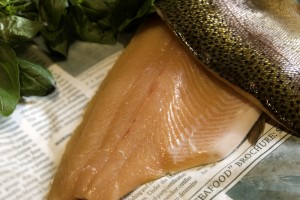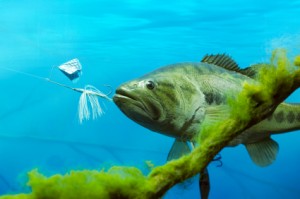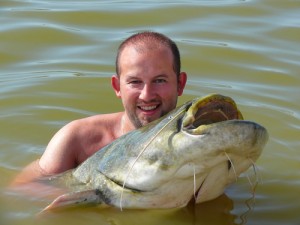Basics of Fly Fishing in Cold Water
The popularity of fly fishing in cold water has grown exponentially over the last decade. This is because fly angling is not as difficult or expensive as many people once thought it was. The majority of cold water fly fishing is done in clear rivers and streams in pursuit of trout. Getting started in fly fishing takes practice and patience, but once the basics are understood, this type of fishing will become an activity that can be enjoyed for the rest of one’s life. Trout do not live in ugly places and much of the inherent pleasures of fly fishing involve taking in your surroundings - it is never just about catching a certain number of fish.
Getting Started
There is basic tackle that is necessary to procure before a person can fly fish. Because there are many types of fly fishing rods on the market, it is best to keep things simple. For beginners, a 9-foot, five-weight rod is a versatile tool that will work for most trout fishing situations. Look for a rod that is of medium to fast-action. There is no reason for someone new to the sport to spend over $250 on this piece of equipment until they decide if fly fishing is something they want to keep doing. Fly fishing reels are not often utilized, so a basic model will be fine to start. To complete this setup, a five-weight, weight-forward, floating fly line should be purchased.
Fishing for Redbreast Sunfish
The Redbreast Sunfish is known as being one of the easiest and fun fish to catch. They are sometimes known by these other names: redbelly, robin, bream, longear sunfish, sun perch, river bream, redbreast bream and  yellowbelly sunfish. Redbreasts are easily one of the brightest and vibrant in color out of all the sunfishes. The male and female vary in colors, with the males having a yellow, orange or red breast, green upper side which blends into a light-blue on the lower sides and light blue streets along their cheeks. Females, however, are less vibrant and are typically a yellow or pale red. The most unique distinction in their looks is a long and skinny extension of the gill cover that is solid black.
yellowbelly sunfish. Redbreasts are easily one of the brightest and vibrant in color out of all the sunfishes. The male and female vary in colors, with the males having a yellow, orange or red breast, green upper side which blends into a light-blue on the lower sides and light blue streets along their cheeks. Females, however, are less vibrant and are typically a yellow or pale red. The most unique distinction in their looks is a long and skinny extension of the gill cover that is solid black.
The Redbreast Sunfish is a freshwater fish and is native to the rivers of the United States and Canada. They are commonly found in lakes, coastal-plain streams and rivers in almost every inch of the U.S. These fish are extremely versatile in that can live in rocky areas along with sandy-bottom locations. When they are coming together to spawn, they frequently make themselves home around logs, aquatic vegetation and around boulders.
How to Clean and Cook Your Fresh Trout
You’ve just spent the morning rainbow trout fishing in a beautiful high mountain lake in Colorado. Or maybe you’ve been fly fishing for brown or cutthroat trout on the Snake River in Idaho. Wherever you snagged your catch  and whatever variety of trout is in your creel, it’s time to clean those beauties and prepare lunch! Some people think this is almost as fun as catching them! Here are some suggestions for preparing trout.
and whatever variety of trout is in your creel, it’s time to clean those beauties and prepare lunch! Some people think this is almost as fun as catching them! Here are some suggestions for preparing trout.
1. If you have several small trout, you can gut them, remove the heads, roll them in some flour and sauté them in butter. When they are tender and done to perfection, just get a hold of the trout’s backbone and pull. The bones should slip right out, leaving nothing but meat.
Bass Fishing in America
The first time out in the water, it will draw you in. Sitting on the bow of the boat, listening to nature in the early morning hours; the lapping of the waves lulls the bass fisherman into the zone, that magic place where he becomes  one with the natural world. The soft plunk of the line into the deep water feeds his soul. He is a bass fisherman, and he understands the call.
one with the natural world. The soft plunk of the line into the deep water feeds his soul. He is a bass fisherman, and he understands the call.
America is home to several species of bass. From the most popular largemouth bass to the spotted bass, Americans are in love with bass fishing. Whether trekking along a small stream of a winding river, or testing the deep waters of a scenic mountain lake, many Americans spend their leisure time pursuing the sport of bass fishing. Bass fishing is the single most popular freshwater sport in the United States.
Bass enthusiasts know the value of good equipment. From plastic worms to the best jigs, the avid fisherman can tell you the right one for the best catch. Here are just a few basics.
Catfish Fishing: Going after the Big Boys
There is nothing quite so relaxing as drowning worms all day in sear of regular catfish for a  taste fish fry. However, there comes a point in every catfish fisherman’s development when he feels the call to go after the big boys. Unlike most freshwater fish, catfish can reach simply gargantuan proportions that are often in excess of fifty pounds, and it is likely that any water way with a healthy population of catfish will have some of these monsters lurking nearby. While going after the big boys requires considerably more strategy and patience than leisurely fishing, the first time that you land a monster catfish is a moment that you will never forget.
taste fish fry. However, there comes a point in every catfish fisherman’s development when he feels the call to go after the big boys. Unlike most freshwater fish, catfish can reach simply gargantuan proportions that are often in excess of fifty pounds, and it is likely that any water way with a healthy population of catfish will have some of these monsters lurking nearby. While going after the big boys requires considerably more strategy and patience than leisurely fishing, the first time that you land a monster catfish is a moment that you will never forget.
Before diving into the strategy of catching a huge catfish, let’s start with making sure that you the right tools for the job. While any fisherman who is worth his salt should be able to tell what kinds of poles can handle a big catch, it is crucial that you put some thought into whether your reel is right for the job as well. At the same time, you want to make sure that you have the proper tackle in the field, including fresh fishing line that has a high enough test strength to handle the weight of a major fish. You definitely do not want to get one hooked only to lose it to the snap of a moldy fishing line.
